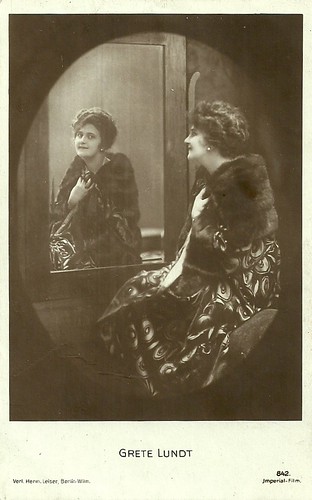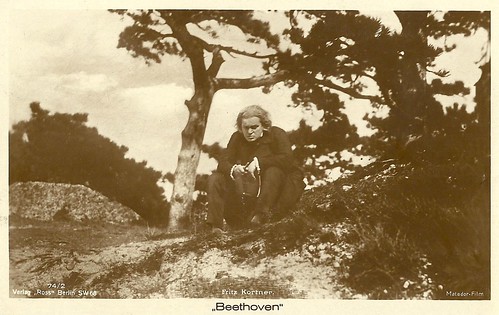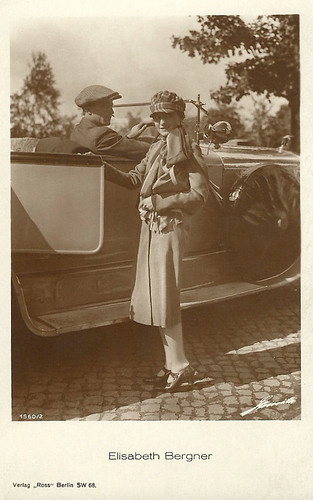Grete Lundt aka Grete Lund (1892-1926) was as an Austrian stage and screen actress, who played in Austrian and German silent films. Lundt’s career went down by lack of work and money, aggravated by a morphine addiction. She committed suicide in the Vienna-Berlin D-train, only 34 years old.

German postcard by Verlag Hermann Leiser, no. 842. Photo: Imperial-Film.
Grete Lundt (sometimes written as Lund) was born Gisela Kovacs in 1892 in Temesvár, in the Austrian-Hungarian Empire (now Romania). She originated from the people of the so-called Banater Schwaben (Banat Swabians, an ethnic German population in Southeast Europe). She visited a commercial school and worked as an office worker from 1906 onwards. She then completed singing and dancing training as well as private acting lessons in Berlin with Gertrud Arnold.
In 1914 she debuted on screen at Wiener Kunstfilm, and in the following years she received major and secondary roles in their Austrian productions. At Wiener Kunstfilm, Jakob and Luise Fleck directed her in such films as Der Traum eines österreichischen Reservisten (1915), Meineidbauer (1915), and Die Tragödie auf Schloss Rottersheim (1916).
In the late 1910s, she moved to the Austrian company Leyka-Film, where she had a lead in Frauenehre (Georg Kundert, 1918), in addition to minor parts in various other films at Leyka. (Filmportal.de writes that Fauenehre is an Imperial Film production, while IMDb says it was produced by Leyka-Film). In Frauenehre, Joseph Reithofer plays a man who must choose between saving his friend (Fritz Hofer) from an unjust accusation of murder and revealing his own affair with the judge’s wife (Lundt). The real murderer was played by Fritz Kortner.
With Kortner, Grete Lundt also played in Ohne Zeugen (Erwin Baron, Georg Kundert, 1919). That year, she played in 6 films at the Austrian company Filmag with e.g. Kortner and Joseph Schildkraut, such as Das Auge des Buddha (Maurice Armand-Mondet, 1919), Die schwarze Fahne (Ludwig Stein [Paul L. Stein], 1919), and Der Diamant des Todes (Leo Stoll, 1919).
In 1919 she moved to Munich for a major part in Franz Seitz’s film Verlorenes Spiel (1919), produced by the local Transatlantic Film Co (Trafilco) with the Trafilco star Lili Dominici, and Fritz Kampers. Lundt’s last Austrian films were two films by Paul Czinner: the proto-expressionist film Inferno (1919), Czinner’s debut, and Homo immanis (1919), the latter with Ivan Petrovich, and the film Der verarmte Edelmann (Georg Kundert, 1920).

Fritz Kortner. German postcard by Ross Verlag, Berlin, no. 74/2, 1925-1935. Photo: Matador-Film. Publicity still for Das Leben des Beethoven/The Life of the Beethoven (Hans Otto, 1927). Collection: Didier Hanson.
In 1920 Grete Lundt returned to Berlin, where she first played in various films, such as Frauen… (William Kahn, Siegfried Dessauer, 1920) with Ludwig Trautmann, Der gelbe Diplomat (Fred Sauer 1920) with Friedrich Zelnik and Käthe Haack, and Der Mann mit den drei Frauen (Fred Sauer, 1920), again with Zelnik. The latter two films were Zelnik-Mara-Film productions.
After a part as the film diva named Nuja-Naja in the comedy Miss Rockefeller filmt (Erich Schönefelder, 1922), starring Georg Alexander and Stella Arbenina, Lundt’s last role was a minor part in Paul Czinner’s German production Nju (1924), starring Elisabeth Bergner, Emil Jannings and Conrad Veidt. Filmportal.de mentions a second German film of 1924, produced by Imperial-Film production, Wenn Männer schweigen (1924), but based on the credits this can be identified as a German rerelease of the 1918 Austrian production Frauenehre. So Imperial-Film may have been just a distributor, or rather IMDb is wrong and has mixed up the two films.
In Germany, Lundt concentrated more and more on her stage work. She appeared mainly at the theatres of Victor Barnowsky and the Meinhard Bernauer stages, after which she could be seen in Rosa Valetti's cabaret Die Rampe (The Ramp), which existed between late 1922 and 1925. According to the Austrian paper Die neue Zeitung, Lundt had married film director Paul Czinner after his first wife (Gilda Langer) had died of the Spanish flu but the two later on broke up. Perhaps Czinner’s affair with Bergner, which started during the production of Nju, had to do with it.
Lundt was befriended by Julius Barmat, the Jewish merchant who would be the centre of the Barmat Scandal, which discredited the SDP because of the exposure of wide-spread corruption. It also raised anti-Semitism, and helped the right wing to win the 1925 elections. Barmat had helped Lundt financially, but when he was arrested on New Year’s Eve 1924 Lundt lost her maecenas.
Lundt’s career went down because of a lack of work and money, aggravated by a morphine addiction. To pay for the costs of a morphine addict's clinic, she had to sell her house and all her belongings. When a last attempt to get a job in Vienna failed, on New Year’s Eve 1926, desperate for her constant lack of engagements and finance, Grete Lundt committed suicide in the Vienna-Berlin D-train (other sources say Frankrfurt-Berlin), using an overdose of morphine. Grete Lundt died on 31 December 1926. She was only 34.

Elisabeth Bergner. German postcard by Ross Verlag, no. 1560/2, 1927-1928. Photo: Geiringer-Horovitz, Wien. Collection: Didier Hanson.
Sources: Stephanie D'heil (Steffi-Line - German), Filmportal.de, Wikipedia (German), and IMDb.
This post was last updated on 11 April 2025.

German postcard by Verlag Hermann Leiser, no. 842. Photo: Imperial-Film.
Proto-expressionist film
Grete Lundt (sometimes written as Lund) was born Gisela Kovacs in 1892 in Temesvár, in the Austrian-Hungarian Empire (now Romania). She originated from the people of the so-called Banater Schwaben (Banat Swabians, an ethnic German population in Southeast Europe). She visited a commercial school and worked as an office worker from 1906 onwards. She then completed singing and dancing training as well as private acting lessons in Berlin with Gertrud Arnold.
In 1914 she debuted on screen at Wiener Kunstfilm, and in the following years she received major and secondary roles in their Austrian productions. At Wiener Kunstfilm, Jakob and Luise Fleck directed her in such films as Der Traum eines österreichischen Reservisten (1915), Meineidbauer (1915), and Die Tragödie auf Schloss Rottersheim (1916).
In the late 1910s, she moved to the Austrian company Leyka-Film, where she had a lead in Frauenehre (Georg Kundert, 1918), in addition to minor parts in various other films at Leyka. (Filmportal.de writes that Fauenehre is an Imperial Film production, while IMDb says it was produced by Leyka-Film). In Frauenehre, Joseph Reithofer plays a man who must choose between saving his friend (Fritz Hofer) from an unjust accusation of murder and revealing his own affair with the judge’s wife (Lundt). The real murderer was played by Fritz Kortner.
With Kortner, Grete Lundt also played in Ohne Zeugen (Erwin Baron, Georg Kundert, 1919). That year, she played in 6 films at the Austrian company Filmag with e.g. Kortner and Joseph Schildkraut, such as Das Auge des Buddha (Maurice Armand-Mondet, 1919), Die schwarze Fahne (Ludwig Stein [Paul L. Stein], 1919), and Der Diamant des Todes (Leo Stoll, 1919).
In 1919 she moved to Munich for a major part in Franz Seitz’s film Verlorenes Spiel (1919), produced by the local Transatlantic Film Co (Trafilco) with the Trafilco star Lili Dominici, and Fritz Kampers. Lundt’s last Austrian films were two films by Paul Czinner: the proto-expressionist film Inferno (1919), Czinner’s debut, and Homo immanis (1919), the latter with Ivan Petrovich, and the film Der verarmte Edelmann (Georg Kundert, 1920).

Fritz Kortner. German postcard by Ross Verlag, Berlin, no. 74/2, 1925-1935. Photo: Matador-Film. Publicity still for Das Leben des Beethoven/The Life of the Beethoven (Hans Otto, 1927). Collection: Didier Hanson.
Desperate for her constant lack of engagements and finance
In 1920 Grete Lundt returned to Berlin, where she first played in various films, such as Frauen… (William Kahn, Siegfried Dessauer, 1920) with Ludwig Trautmann, Der gelbe Diplomat (Fred Sauer 1920) with Friedrich Zelnik and Käthe Haack, and Der Mann mit den drei Frauen (Fred Sauer, 1920), again with Zelnik. The latter two films were Zelnik-Mara-Film productions.
After a part as the film diva named Nuja-Naja in the comedy Miss Rockefeller filmt (Erich Schönefelder, 1922), starring Georg Alexander and Stella Arbenina, Lundt’s last role was a minor part in Paul Czinner’s German production Nju (1924), starring Elisabeth Bergner, Emil Jannings and Conrad Veidt. Filmportal.de mentions a second German film of 1924, produced by Imperial-Film production, Wenn Männer schweigen (1924), but based on the credits this can be identified as a German rerelease of the 1918 Austrian production Frauenehre. So Imperial-Film may have been just a distributor, or rather IMDb is wrong and has mixed up the two films.
In Germany, Lundt concentrated more and more on her stage work. She appeared mainly at the theatres of Victor Barnowsky and the Meinhard Bernauer stages, after which she could be seen in Rosa Valetti's cabaret Die Rampe (The Ramp), which existed between late 1922 and 1925. According to the Austrian paper Die neue Zeitung, Lundt had married film director Paul Czinner after his first wife (Gilda Langer) had died of the Spanish flu but the two later on broke up. Perhaps Czinner’s affair with Bergner, which started during the production of Nju, had to do with it.
Lundt was befriended by Julius Barmat, the Jewish merchant who would be the centre of the Barmat Scandal, which discredited the SDP because of the exposure of wide-spread corruption. It also raised anti-Semitism, and helped the right wing to win the 1925 elections. Barmat had helped Lundt financially, but when he was arrested on New Year’s Eve 1924 Lundt lost her maecenas.
Lundt’s career went down because of a lack of work and money, aggravated by a morphine addiction. To pay for the costs of a morphine addict's clinic, she had to sell her house and all her belongings. When a last attempt to get a job in Vienna failed, on New Year’s Eve 1926, desperate for her constant lack of engagements and finance, Grete Lundt committed suicide in the Vienna-Berlin D-train (other sources say Frankrfurt-Berlin), using an overdose of morphine. Grete Lundt died on 31 December 1926. She was only 34.

Elisabeth Bergner. German postcard by Ross Verlag, no. 1560/2, 1927-1928. Photo: Geiringer-Horovitz, Wien. Collection: Didier Hanson.
Sources: Stephanie D'heil (Steffi-Line - German), Filmportal.de, Wikipedia (German), and IMDb.
This post was last updated on 11 April 2025.
No comments:
Post a Comment